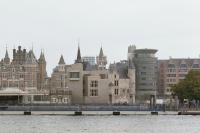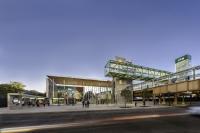House with two facal points
Niigata, Japan
The house is located on the western edge of the Niigata plains.
In this area, Mt. Yahiko and Mt. Kakuda rise about 600m above sea level, standing as regional landmarks between plains and the sea. The client hoped that he could look out his windows at the two mountains he had been accustomed to seeing from childhood. However, when we surveyed the site before designing the house, we found that even from the second floor, Mt. Kakuda was obstructed by other houses and not visible. Only Mt. Yahiko was visible, but the possibility existed that even this view would disappear if a new house were built in the future.
Yet we felt that even if both mountains disappear from view they will remain an important identity for this house, suggesting the existence of the wider world beyond the narrow space of the site. We designed the house as a compass that incorporates a consciousness of the two mountains into the daily life of the residents.
Two focuses
The facade is composed of two slanted surfaces positioned without reference to the alignment of the site. One is angled from the center of the house towards Mt. Yahiko, while the other faces Mt. Kakuda.
Assuming that surroundings will change in the future, the large windows on either side are intended to reveal not a “mountain view” but rather a "hint of the mountain" – a concept that will remain even if the surroundings change. The house becomes the place where the two mountains intersect.
"The first floor that was enlarged " and "The second floor that was shortened"
On the first floor, mirrors were affixed to both ends of a long passage. These mirrors enlarge the appearance of the passage far beyond its actual length. Bright light enters from windows on both sides and illuminates the room, emphasizing the darkness of the Andean Rosewood boards.
These design elements stand in direct contrast to those used on the second floor. Rooms on the second floor open radially toward the exterior walls. Both walls and furniture are arranged radially, and the ceiling slopes upward toward the windows. Through these design elements, the depth of the second floor is shortened and residents feel closer to the external environment. In this space, they become increasingly conscious of the angled exterior walls and of the "hint of the mountains."
The exterior walls come together to form an obtuse angle giving rise to a sense that the interior has entered the external environment. At the same time, because of its unique design, this building has become a minor landmark in an average town that had been lacking energy.
https://www.future-scape.co.jp/g2051engrishspanish/g205303works/g205303worksimage/g2053i03housewithtfp/g2053i03housewithtfpeg.html
- Architetti
- Daigo Ishii + Future-scape Architects
- Sede
- Niigata, Japan
- Anno
- 2008
















